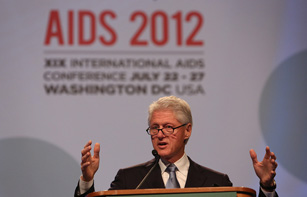
Bill Clinton addressing delegates at the closing session of the XIX International AIDS Conference in Washington, D.C. The conference was held from 22-27 July.
Credit: UNAIDS/C.Kleponis
The XIX International AIDS Conference concluded in Washington, DC on Friday after five days of hundreds of sessions, programme activities, workshops, poster presentations and side-events aimed at bringing forward the latest thinking and developments in the global HIV response.
The conference, which opened on 22 July, was organized under the theme “Turning the Tide Together.” Presenters at AIDS 2012, from senior government officials and heads of international organizations to civil society leaders and scientists, all echoed that for the first time in the history of AIDS, an end to the epidemic is on the horizon. However, speakers cautioned that there are still numerous challenges that must be addressed before the international community reaches zero new HIV infections and zero AIDS-related deaths.
Throughout the conference, much attention focused on the 10 global AIDS targets agreed upon by UN Member States at the UN High Level Meeting on AIDS held in June 2011—in particular the goal of eliminating new HIV infections among children, reducing sexual transmission of HIV by 50% and getting 15 million people on HIV treatment, all by 2015. Representatives of both international organizations and civil society stressed that unless investments in the HIV response are increased, the goals will not be realized.
Of the 16.8 billion dollars now being invested annually in this effort more than half of it comes from the affected countries themselves and they deserve an enormous amount of credit for that.
President Bill Clinton
Ahead of AIDS 2012, UNAIDS released a new report, titled Together we will end AIDS, that outlined the recent gains made in achieving the global AIDS targets, including increases in HIV treatment coverage and domestic investments in low- and middle-income countries.
Leaders reiterate commitment to an AIDS-free generation
The conference also provided an opportunity for many people from the worlds of politics, science, civil society and the arts to reiterate their support to the effort to end new HIV infections among children by 2015 and keep their mothers alive. An event held on the eve of the conference, Uniting for an AIDS-free generation, brought together musicians, politicians, scientists and activists to rally more support for the goal.

Elly Katabira, IAS President and AIDS 2012 Chair, introducing Nobel Laureate Françoise Barré-Sinoussi, Incoming President of the IAS.
At the conference, several sessions focused on sharing progress to date in stopping mother to child transmission of HIV. UNAIDS Executive Director Michel Sidibé, and Ambassador Eric Goosby, U.S. Global AIDS Coordinator, participated in many events to update partners on the Global Plan, a joint initiative focusing on the 22 countries in which 90% of new HIV infections in children occur, 21 of which are in sub-Saharan Africa.
AIDS 2012 concludes, delegates look to AIDS 2014
The closing session on 27 July featured several addresses from prominent advocates in the global HIV response. Speakers included: Diane Havlir, AIDS 2012 U.S. Co-Chair; Nancy Pelosi, Minority Leader, US House of Representatives; Anna Zakowicz, Global Network of People Living with HIV (GNP+); Elly Katabira, IAS President and AIDS 2012 Chair; Nobel Laureate Françoise Barré-Sinoussi, Incoming President of the IAS; Tanya Plibersek, Australian Minister of Health; and President Bill Clinton.
At the end of the opening session, the conference was handed over to officials representing the organizing committee of the XX International AIDS Conference, which will be held in Melbourne, Australia in 2014.
AIDS 2012 was the first International AIDS Conference to be held in the US in 22 years. The decision by President Obama to lift an HIV travel ban in 2009 was widely acclaimed by all delegates, as a sign of the continued bi-partisan commitment of the US government in responding to HIV, both domestically and internationally.
An estimated 23 000 participants from some 200 countries, and 1800 media representatives attended AIDS 2012. Hundreds of sessions, programme activities, workshops, poster presentations and side-events were held between 22-27 July.





